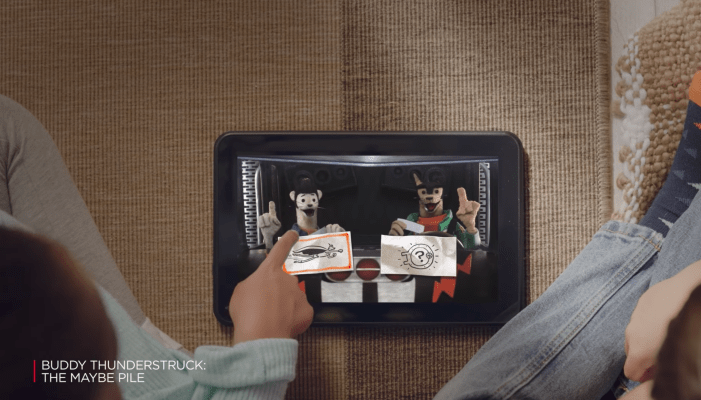Netflix today announced the debut of “interactive” stories on its service – a sort of choose-your-own-adventure style of storytelling, where viewers get to decide what happens next. The new stories, whose development was rumored earlier this year, will initially cater to Netflix’s younger viewers, the company says, noting that kids in particular are already inclined to “play” with their favorite characters, as well as touch and swipe on their screens.
That decision doesn’t necessarily rule out bringing a similar format to adult viewers at a later date, but Netflix hasn’t yet announced any plans in that area.
The first stories available include “Puss in Book: Trapped in an Epic Tale,” which launches globally today, and “Buddy Thunderstruck: The Maybe Pile,” which hits on July 14. The third branching narrative, as Netflix calls these stories, is “Stretch Armstrong: The Breakout,” which will arrive sometime next year.
The “Puss in Book” story pauses 13 times to offer choices, and has two different endings available. It can last 18 to 39 minutes, depending on viewers’ selections.
Netflix says the titles will be available on most of its TV platforms, as well as on iOS devices. The Netflix website, Android Devices, Chromecast and Apple TV do not support interactive content at this time.
As kids watch the story, they’ll be presented with different choices for the characters, allowing them to shape the story and the action as they go. That means these same titles can be watched again and again, with different results.
Ahead of the launch, Netflix says it talked with parents to get feedback on the idea. The parents were encouraged by the fact that the format itself is more engaging and had their kids making decisions.
But the launch of the stories is still very much an experiment for Netflix – something it says it’s able to do because of the freedom in being an internet-based company. The goal now is to see how users actually engage with the content, and learn from those results. The company is looking to discover which storylines prove popular, whether or not the stories promote repeat viewing, and more.
The format could make sense for Netflix as a way of better entertaining children – which could then help attract and retain families to Netflix’s service. However, while choose-your-own-adventure has worked well for books and even later on digital through apps and games, translating the format to video requires more production time than traditional linear programming, and comes with its own technical challenges as well. For example, how to make fast forward and rewind work when the story has multiple branches.
However, more broadly, interactive stories are merely a twist on a trend already common in children’s TV: breaking the fourth wall. From the early days of children’s programming, to Sesame Street, and then newer shows like “Dora,” characters talk to the kids through the TV and ask them to engage or take an action. This has proven to help kids retain more of the information, if the program is educational, but it also makes Netflix’s new interactive format more approachable for young viewers.
